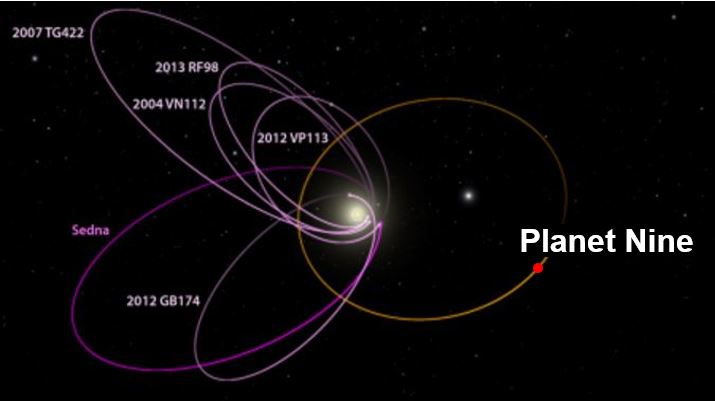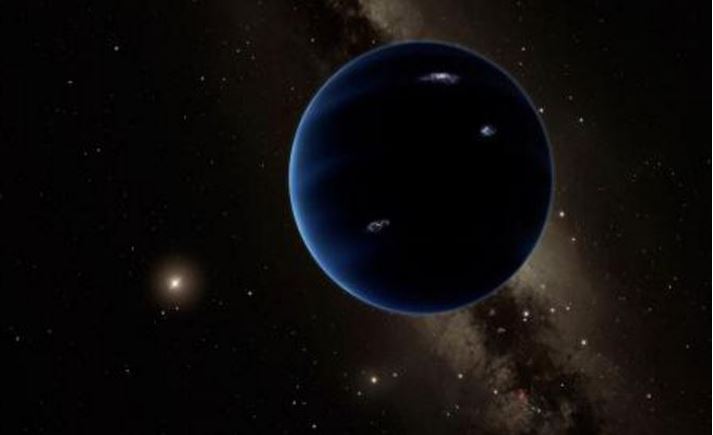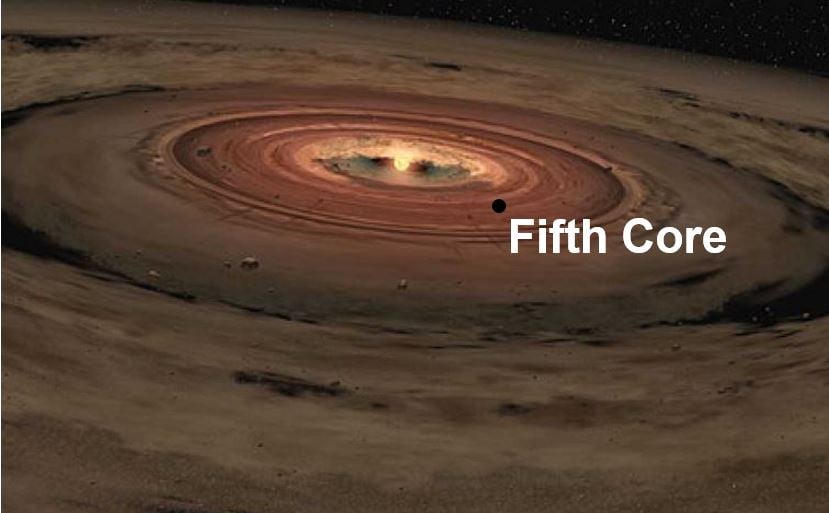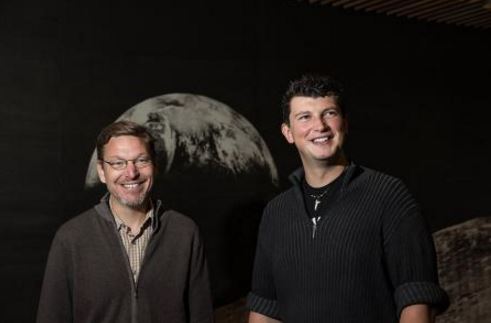A ninth planet, currently dubbed Planet Nine, has been discovered far out in our solar system by Caltech scientists. It has a mass ten times that of Earth, is approximately four times its size, and has a weird orbit, which takes between 10,000 and 20,000 years to complete, i.e. one year on Planet Nine is equivalent to up to 20,000 Earth years.
The newly-discovered planet, which has astronomers across the world buzzing with excitement, is 20 times further away from the Sun than Neptune, which with an average distance of 2.8 billion miles is already quite distant.
Professors Konstantin Batygin and Mike Brown, from the Division of Geological and Planetary Sciences at the California Institute of Technology (Caltech), wrote about their discovery in the Astronomical Journal.
 An artist’s impression of the 6 most distant known objects in the solar system with orbits exclusively beyond Neptune. They all mysteriously line up in a single direction. (Image: Caltech/R. Hurt)
An artist’s impression of the 6 most distant known objects in the solar system with orbits exclusively beyond Neptune. They all mysteriously line up in a single direction. (Image: Caltech/R. Hurt)
They discovered compelling evidence of Planet Nine through mathematical modelling and computer simulations, but have not yet observed it directly.
There’s a lot we haven’t seen in our solar system
Brown, the Richard and Barbara Rosenberg Professor of Planetary Astronomy, commented:
“This would be a real ninth planet. There have only been two true planets discovered since ancient times, and this would be a third. It’s a pretty substantial chunk of our solar system that’s still out there to be found, which is pretty exciting.”
This new object is definitely a true planet and not a dwarf one, like Pluto, the authors insist. It is five thousand times the mass of Pluto.
The authors found that Planet Nine’s gravity is the dominant force in its neighbourhood. In fact, out of the nine planets that we now know orbit the Sun, its gravitational pull covers the largest region – which the scientists say makes it “the most planet-y of the planets in the whole solar system.”
Planet Nine will help astronomers answer many questions regarding the enigmatic features of the Kuiper Belt – a region of the solar system beyond the orbit of Neptune, which contains many comets, asteroids, and other small bodies made largely of ice and rock.
 An artist’s impression of Planet Nine, the ninth planet in our solar system, with the Sun in the background. It is thought to be a gaseous planet, similar to Neptune and Uranus. (Image: Caltech/R. Hurt)
An artist’s impression of Planet Nine, the ninth planet in our solar system, with the Sun in the background. It is thought to be a gaseous planet, similar to Neptune and Uranus. (Image: Caltech/R. Hurt)
From doubtful to convinced
Batygin, an Assistant Professor of Planetary Science at Caltech, said:
“Although we were initially quite skeptical that this planet could exist, as we continued to investigate its orbit and what it would mean for the outer solar system, we become increasingly convinced that it is out there.”
“For the first time in over 150 years, there is solid evidence that the solar system’s planetary census is incomplete.”
In 2014, Brown’s former postdoc Chad Trujillo, and Scott Sheppard, published a paper noting that thirteen distant Kuiper Belt objects were similar regarding their obscure orbital feature.
Trujillo and Sheppard suspected that this strange orbit was caused by a small planet. Brown thought this was unlikely, but became interested in the mystery.
 Astronomers believe there were 4 cores in the early solar system when planets were being formed, which produced the gas planets – Neptune, Uranus, Saturn and Jupiter. Maybe Planet Nine comes from a fifth core.
Astronomers believe there were 4 cores in the early solar system when planets were being formed, which produced the gas planets – Neptune, Uranus, Saturn and Jupiter. Maybe Planet Nine comes from a fifth core.
He talked to Batygin about it, and the two scientists began what became a two-year collaboration to research distant objects.
The observer and the theorist work together
So, Brown the observer and Batygin the theorist worked together. Brown was trained to look at the sky and try to anchor everything in the context of what can be seen, while Batygin looks at everything from the dynamics perspective, i.e. determining how things could work from a physics point of view.
The authors said the two different approaches, when put together, work well. They were able to challenge each other’s ideas and consider new possibilities.
Regarding how they worked together, Brown said:
“I would bring in some of these observational aspects; he would come back with arguments from theory, and we would push each other. I don’t think the discovery would have happened without that back and forth.”
“It was perhaps the most fun year of working on a problem in the solar system that I’ve ever had.”
 Professors Mike Brown (left) and Konstanin Batygin have been working together to investigate distant objects and planets in our solar system for over two years. They bring very different perspectives to the work – Batygin is the theorist while Brown is the observer. (Image: Lance Hayashida/Caltech)
Professors Mike Brown (left) and Konstanin Batygin have been working together to investigate distant objects and planets in our solar system for over two years. They bring very different perspectives to the work – Batygin is the theorist while Brown is the observer. (Image: Lance Hayashida/Caltech)
Bizarre orbital patterns observed
They found that the six most distant Kuiper Belt objects from Trujillo and Sheppard’s observation all follow an orbital path that points in the same direction in physical space. This was a surprise, because they all travel at varying speeds and the outermost points of their orbits move around the solar system.
Imagine a clock with six hands, all the hands moving it different velocities. However, they are all in the same place when you look up at them. There is a less than 1% chance of something like that occurring randomly, Brown explained.
They also discovered that the six objects all tilted in the same way – pointing to 30 degrees downward in the same direction in relation to the plane of the eight planets known to us.
The chances of that happening are smaller still – about 0.007%. “Basically it shouldn’t happen randomly. So we thought something else must be shaping these orbits,” Brown said.
They first tried to rule out the possibility that there were enough distant objects in the Kuiper Belt to exert the required gravity to keep that subpopulation of objects grouped together. There are many objects in the Kuiper Belt that have not yet been discovered.
It did not take them long to rule out that possibility. The Kuiper Belt would have to have about 100 times its current estimated mass for such a scenario to occur.
What was left was the possibility that a planet might be the cause of all this. At first, their instinct was to run simulations involving a planet in a distant orbit that encircled the orbits of the six objects in the Kuiper Belt, acting like a giant lasso to bring them into alignment.
While that might nearly work, it does not precisely explain the eccentricities observed. Batygin said “Close, but no cigar.”
Massive planet explanation reached accidentally
Then purely by accident, Brown and Batygin found that if a massive planet was used in their simulations, in an anti-aligned orbit, the Kuiper Belt objects assumed the alignment that is actually observed.
Batygin said:
“Your natural response is ‘This orbital geometry can’t be right. This can’t be stable over the long term because, after all, this would cause the planet and these objects to meet and eventually collide.’”
However, using a mechanism called mean-motion resonance, Planet Nine’s anti-aligned orbit prevents the Kuiper Belt objects from colliding with it and keeps them aligned.
Orbiting planets and objects exchange energy as they approach each other. So, for instance, for every four orbits Planet Nine makes, a distant Kuiper Belt object might complete nine.
Planet Nine and the objects never crash into each other. Rather, like an adult pushing a child on a swing periodically and maintaining an arc, the big planet nudges the orbits of the objects so that their configuration in relation to the planet is preserved.
“Still, I was very skeptical. I had never seen anything like this in celestial mechanics,” Batygin said.
However, after investigating more consequences and features of the model, the two scientists eventually became persuaded.
“A good theory should not only explain things that you set out to explain. It should hopefully explain things that you didn’t set out to explain and make predictions that are testable,” Batygin said.
Planet Nine clarifies alignment and bizarre orbits mystery
Planet Nine explains two mysteries: 1. The alignment of the distant Kuiper belt objects. 2. The strange orbits.
The first of these objects, dubbed Sedna, was discovered by Brown in 2003. Sedna never gets too near to Neptune, unlike most other Kuiper Belt objects, which get kicked out by Neptune’s gravity.
2012 VP113, a second object, which is similar to Sedna, was announced in 2014 by Trujillo and Sheppard.
Batygin and Brown found that Planet Nine’s presence in its proposed orbit naturally produces Sedna-like objects by gradually pulling away a standard Kuiper Belt object into an orbit less connected to Neptune.
The scientists were most surprised when their simulations also predicted that there are probably objects in the Kuiper Belt that follow orbits that are inclined perpendicularly to the plane of the planets.
As Batygin found a large number of these in his simulation, he took them to Brown. “Suddenly I realized there are objects like that,” Brown recalled.
Over the last thirty-six months, observers have detected four objects following orbits along one perpendicular line from Neptune and one object along another.
After plotting the positions of those objects, and also their orbits, Brown found that they matched the simulations precisely. “When we found that, my jaw sort of hit the floor,” Brown said.
Stone kills two birds plus one to boot
Batygin said:
“When the simulation aligned the distant Kuiper Belt objects and created objects like Sedna, we thought this is kind of awesome – you kill two birds with one stone.”
“But with the existence of the planet also explaining these perpendicular orbits, not only do you kill two birds, you also take down a bird that you didn’t realize was sitting in a nearby tree.”
The question now is ‘Where did this ninth planet come from? Why is it where it is? How did it get there?’
Scientists have long believed that the early solar system began with four planetary cores that sucked in all the gas around them, forming Jupiter, Saturn, Uranus and Neptune – the four gas planets.
Over time, they were shaped following collisions and ejections, and then moved to their current locations.
Perhaps there were five planetary cores
“But there is no reason that there could not have been five cores, rather than four,” said Brown.
Maybe Planet Nine comes from a fifth core that existed in the early solar system. If it got too close to Jupiter or Saturn, it may have been kicked into its current faraway, eccentric orbit.
Batygin and Brown are still learning new things about the planet’s orbit and its impact on objects in the distant solar system as they work on improving their simulations.
Big race to ‘see’ Planet Nine
A different team, led by Brown, is currently scanning the skies for the elusive Planet Nine. We know it travels along its unusual orbit, but we have no way of knowing where exactly it is – it could be at its closest distance from the Sun, furthest distance, or somewhere in between.
If it is close to its perihelion (the point in the orbit which it is closest to the sun), astronomers should be able to detect it using images captured by previous surveys. If it is close to its aphelion (the point in the orbit which it is furthest from the sun), we’ll need the world’s largest telescopes to see it. If it is somewhere in between, there are hundreds of telescopes that could be used.
Brown said:
“I would love to find it. But I’d also be perfectly happy if someone else found it. That is why we’re publishing this paper. We hope that other people are going to get inspired and start searching.”
There are two ways Planet Nine makes our solar system more similar to other planetary systems that scientists are discovering around other stars.
1. The majority of planets around other stars out there, especially those similar to our Sun, have no single orbital range – some are super-near their host stars while others are in mega-distant orbits.
2. Most common planets that orbit other stars in the Universe range in size from 1 to 10 Earth masses.
Batygin said:
“One of the most startling discoveries about other planetary systems has been that the most common type of planet out there has a mass between that of Earth and that of Neptune.”
“Until now, we’ve thought that the solar system was lacking in this most common type of planet. Maybe we’re more normal after all.”
Brown, who was closely involved in demoting Pluto from a planet to a dwarf planet, said:
“All those people who are mad that Pluto is no longer a planet can be thrilled to know that there is a real planet out there still to be found,” he says. “Now we can go and find this planet and make the solar system have nine planets once again.”
Reference: “Evidence for A Distant Giant Planet in the Solar System,” Michael E. Brown & Konstantin Batygin. The Astronomical Journal. 20th January, 2016. DOI: 10.3847/0004-6256/151/2/22.
Video – There is a Ninth Planet out there orbiting the Sun
Professors Brown and Batygin discuss new research that proves the existence of a giant planet tracing a bizarre, highly elongated orbit in the outer solar system.
Discover more from Market Business News
Subscribe to get the latest posts sent to your email.

